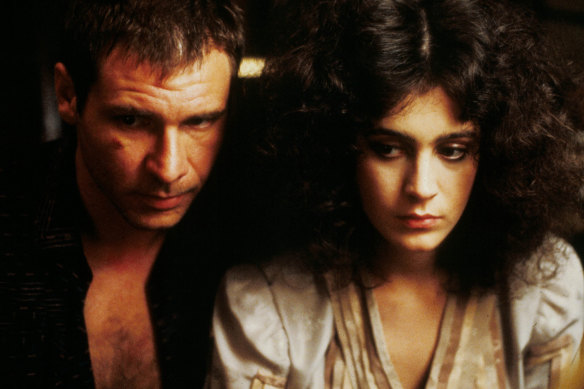This was published 2 years ago
Opinion
Forty years on, Blade Runner’s still peerless as a sci-fi classic
Charles Purcell
WriterForty years ago, Ridley Scott’s sci-fi masterpiece Blade Runner bombed at the box office on its opening weekend, making less than US$6 million on a US$30 million budget.
Critics and audiences called it confusing, a triumph of style and special effects over substance. “Resembling a Felliniesque journey into Dante’s Inferno, with Mickey Spillane in tow, Blade Runner is a cold, bold, bizarre and mesmerising futuristic detective thriller,” wrote The Hollywood Reporter, yet added this important caveat: “Admittedly, it’s a film that will turn off many, but it will also bulge eyeballs and cause talk.”

Harrison Ford played replicant hunter Rick Deckard and Sean Young was Rachel, the replicant girl he falls in love with, in the sci-fi classic Blade Runner.
And cause talk it did. Today, the film, based on Philip K. Dick’s novel Do Androids Dream of Electric Sheep?, is considered one of the best sci-fi movies ever made, with incredible performances by Harrison Ford, Sean Young and Rutger Hauer (that “I’ve seen things you people wouldn’t believe” soliloquy!), a superb soundtrack by Vangelis, and a question at its core that people are still debating today.
Only a decade after its release the film was considered so influential in academia that I studied it at university, borrowing the videotape from the audiovisual department no less than 20 times (which might explain the knowing smirk from the staff when I appeared at the counter each time).
I even knew someone who said the film made them study origami: specifically, to create tiny origami
unicorns, a reference you would understand too if you’d seen the film 20 times.
Yet on the moment of its 40-year cinematic anniversary, it’s timely to look at what impact the film has had on the wider culture. That impact is indeed massive: for a start, it green lit what might be called the Philip K. Dick industry, leading to movie adaptations of Minority Report, Total Recall and A Scanner Darkly.
Scott’s world of unchecked technology, environmental disaster and extreme wealth disparities has influenced everything from the entire cyberpunk genre and video games to The Matrix and The Hunger Games.
Yet perhaps the most lasting impact of Blade Runner is its look. It makes the future appear both exciting and repulsive; an awe-inspiring cityscape seen from above, yet a grimy hunt for replicants (genetically engineered beings) gone rogue on ground level, set amid neon lights, darkness and endless rain.
The world of Blade Runner is a postmodernist spotter’s dream, full of visual touchstones from corporations living and dead (Atari, TDK, Pan Am), architecture (Frank Lloyd Wright’s Ennis House), subcultures, emerging tech (it got videophones right but flying cars by 2019 wrong) and more.
I could go on and on. So if you haven’t seen Blade Runner yet, I urge you to go see it. Maybe not 20
times, though. Maybe just 10 is enough.
Find out the next TV, streaming series and movies to add to your must-sees. Get The Watchlist delivered every Thursday.